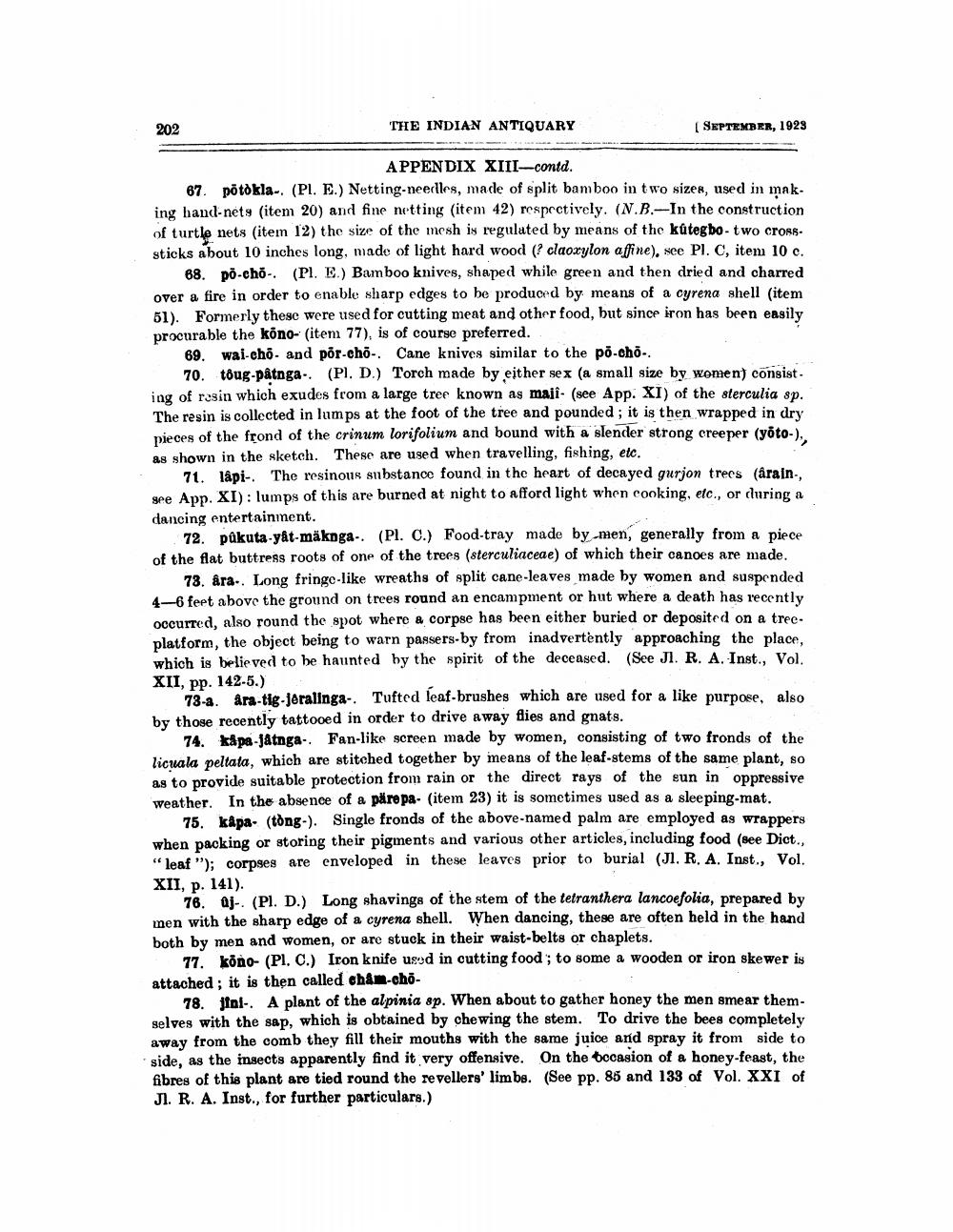________________
202
THE INDIAN ANTIQUARY
( SEPTEMBER, 1923
APPENDIX XIII-contd. 67 pötokla-. (Pl. E.) Netting-neerlles, made of split bamboo in two sizes, used in making hand-nets (item 20) and fine netting (item 42) respectively. (N.B.- In the construction of turtle nets (item 12) the size of the mesh is regulated by means of the küteg bo- two crosssticks about 10 inches long, made of light hard wood ( claoxylon afine), see Pl. C, item 10 c.
88. po.cho.. (Pl. E.) Bamboo knives, shaped while green and then dried and charred over a fire in order to enable sharp edges to be produced by means of a cyrena shell (item 51). Formerly these were used for cutting meat and other food, but since iron has been easily procurable the köno- item 77), is of course preferred.
69. wal-cho. and pôr-cho-. Cane knives similar to the po-cho..
70. tôug-pâtnga. (P. D.) Torch made by either sex (a small size by women) consist. ing of resin which exudes from a large tree known as maji. (see App. XI) of the sterculia sp. The resin is collected in lumps at the foot of the tree and pounded; it is then wrapped in dry pieces of the frond of the crinum lorifolium and bound with a slender strong creeper (yoto-). as shown in the sketch. These are used when travelling, fishing, etc.
71. lâpi-. The resinous substance found in the heart of decayed gurjon trecs (ârain., see App. XI): lumps of this are burned at night to afford light when cooking, etc., or during a dancing entertainment.
72 pakuta-yât-mäkpga.. (Pl. C.) Food-tray made by-men, generally from a piece of the flat buttress roots of one of the trees (sterculiaceae) of which their canoes are made.
73. Ara.. Long fringe-like wreaths of split cane-leaves made by women and suspended 4-6 feet above the ground on trees round an encampment or hut where a death has recently occurred, also round the spot where a corpse has been either buried or deposited on a tree. platform, the object being to warn pansers-by from inadvertently approaching the place. which is believed to be haunted by the spirit of the deceased. (See Jl. R. A. Inst., Vol. XII, pp. 142-5.)
73-a. Ara tig-Joralinga-. Tufted leaf-brushes which are used for a like purpose, also by those recently tattooed in order to drive away flies and gnats.
74. kapa-Jatnga. Fan-like screen made by women, consisting of two fronds of the licuala peltata, which are stitched together by means of the leaf-stems of the same plant, so as to provide suitable protection from rain or the direct rays of the sun in oppressive weather. In the absence of a päre pa- (item 23) it is sometimes used as a sleeping-mat.
75. kapa (tong.). Single fronds of the above-named palm are employed as wrappers when packing or storing their pigments and various other articles, including food (see Dict., " leaf "); corpses are enveloped in these leaves prior to burial (JI. R. A. Inst., Vol. XII, p. 141).
76. Oj-. (Pl. D.) Long shavings of the stem of the tetranthera lancoefolia, prepared by men with the sharp edge of a cyrena shell. When dancing, these are often held in the hand both by men and women, or are stuck in their waist-belts or chaplets.
77. koño- (Pl. C.) Iron knife used in cutting food; to some a wooden or iron skewer is attached; it is then called chån-cho
78. Jin-. A plant of the alpinia sp. When about to gather honey the men smear themselves with the sap, which is obtained by chewing the stem. To drive the bees completely away from the comb they fill their mouths with the same juice and spray it from side to side, as the insects apparently find it very offensive. On the ocasion of a honey-feast, the fibres of this plant are tied round the revellers' limbs. (See pp. 85 and 133 of Vol. XXI of J. R. A. Inst. for further particulars.)




